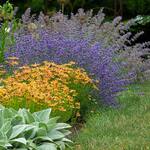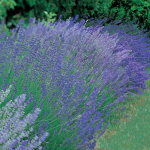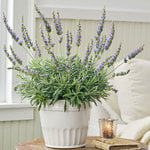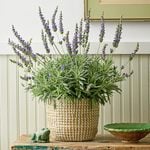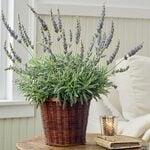Lavender Care (Lavandula)
Latin Name Pronunciation: lav-an'dew-luh
These aromatic subshrubs are popular in herb gardens as well as in the perennial border. The intensely perfumed blue-violet, mauve, pink, or white flowers are treasured for drying and making potpourri. The foliage of Lavender is a standout in the garden where its silvery or gray-green hues contrast nicely with its neighbors. Lavenders thrive in the arid West, but are best grown as annuals or container plants in the South, as they do not thrive in areas of high humidity (with the exception of Lavandula dentata and L. stoechas). Most are hardy from Zones 5 to 9; Spanish Lavender (L. stoechas) is only hardy in Zones 7 to 9.
Growing Lavender
Light/Watering:
- Lavenders demand full sun, although afternoon shade may be appreciated in the hottest climates.
- Plants are very drought resistant once established, but will flower better if not allowed to dry out.
Fertilizer/Soil and pH:
- Lavender thrives in soil that is not fertile
- Supplemental feeding is not necessary although plants may benefit from occasional side dressing of compost.
- Perfect drainage is a must, especially through the winter; plants will die in wet soils.
- A pH close to or slightly above neutral is best, so add lime if your soil has a pH below 7.0.
- Gravel mulch is beneficial and helps to keep the crowns of the plants away from excess moisture.
Pests/Diseases:
- Both the leaves and flowers of Lavender contain strong essential oils that are not appreciated by foraging deer or insect pests.
- In humid climates, fungal problems may arise, but can be avoided by providing excellent drainage and good air circulation around your plants.
Companion Plants: Lavenders are lovely as an edging plant in the garden where they complement many other perennials, including Roses, Hardy Geraniums, Catmints (Calamintha), and Shasta Daisies (Leucanthemum x superba).
Pruning: Lavender is a woody subshrub, and pruning techniques should reflect this.
- Prune in spring after new growth appears
- Plants may be sheared back and shaped after flowering, but do not cut low into old wood.
- Leave plants alone for the winter.
- If older plants become unsightly, cut back by a third every three years.
Harvesting and Using Lavender: Flower spikes have the strongest scent just as the pretty little flowers begin to open.
- Cut long stems and gather in bunches to dry out of the sun – this will take four to five days in warm weather.
- Spread stems on a screen or sheet so air circulates easily.
- Use the stems of fresh or dried flower spikes in arrangements or remove the flowers for sachets and potpourri mixtures.
Reflowering: If old flower spikes are sheared off after the first bloom period, a second flush of flowers may occur later in the season.
Dividing/Transplanting:
- Younger plants handle division better than older, woody specimens.
- Plants may be moved in early spring, but keep plenty of soil around their roots when you dig them up.
Calendar of Care
Early Spring:
- Wait until new growth breaks from the woody stems before pruning.
- Remove deadwood, and shape plants.
- Divide or transplant if needed.
- Side dress plants with compost, keeping it away from the crowns of the plants.
- Check soil pH; if your soil is acidic, correct to a pH between 6.5 and 7.5.
Midspring:
- As the soil warms, mulch around plants with gravel.
Late Spring:
- Shear plants back after flowering is finished.
- Supplement natural rainfall if weather is very dry.
Summer:
- Watch for fungal problems in areas of high humidity and treat as necessary.
Fall:
- Do not cut back stems.
- In severe climates, cover plants lightly with evergreen boughs to buffer drying winter winds.
Types of Lavender Plants
With over three-dozen species in the Lavandula family, it can be a challenge to select the one that best serves your needs. How do you choose between the types of Lavender commonly referred to as English, French, Spanish, Portuguese, and more? In part, your decision depends on what you want to do with your Lavender plants.
Please download our Lavender e-book for a comprehensive tutorial on the different types of Lavender available.
Popular uses include:
- Drying for use in crafts
- Colorful and fragrant fresh cut flower bouquets
- Attractive container plants for indoors or the patio
- Short hedges and borders
- Essential oils
Frequently Asked Questions
Is Lavender a perennial?
Yes, Lavender is a perennial.
Where does Lavender grow best?
Depending on the variety, Lavender grows best in Hardiness Zones 5-8S/10W.
Additional Lavender plant uses?
Many gardeners grow Lavender for its fragrance. But it's also prized for its heat and drought tolerance in hot, dry climates. It attracts bees and is considered deer resistant.
How to Grow Lavender Inside
How to Grow Lavender 'Goodwin Creek Grey' Indoors
The Best Lavender for Growing Indoors: Lavender 'Goodwin Creek Grey'
Lavender Plants We Offer:
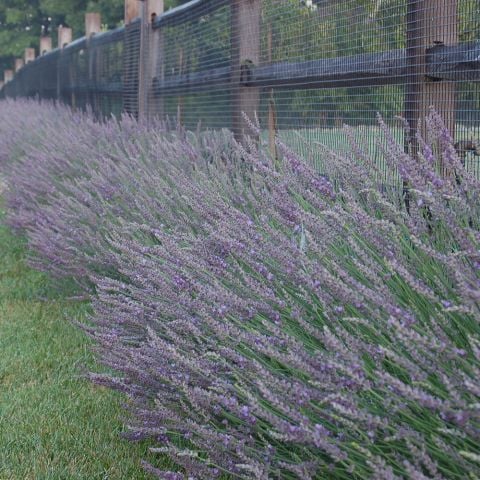 Lavandula x intermedia (Lavender) Phenomenal™ - 1 pint pot
Lavandula x intermedia (Lavender) Phenomenal™ - 1 pint pot

